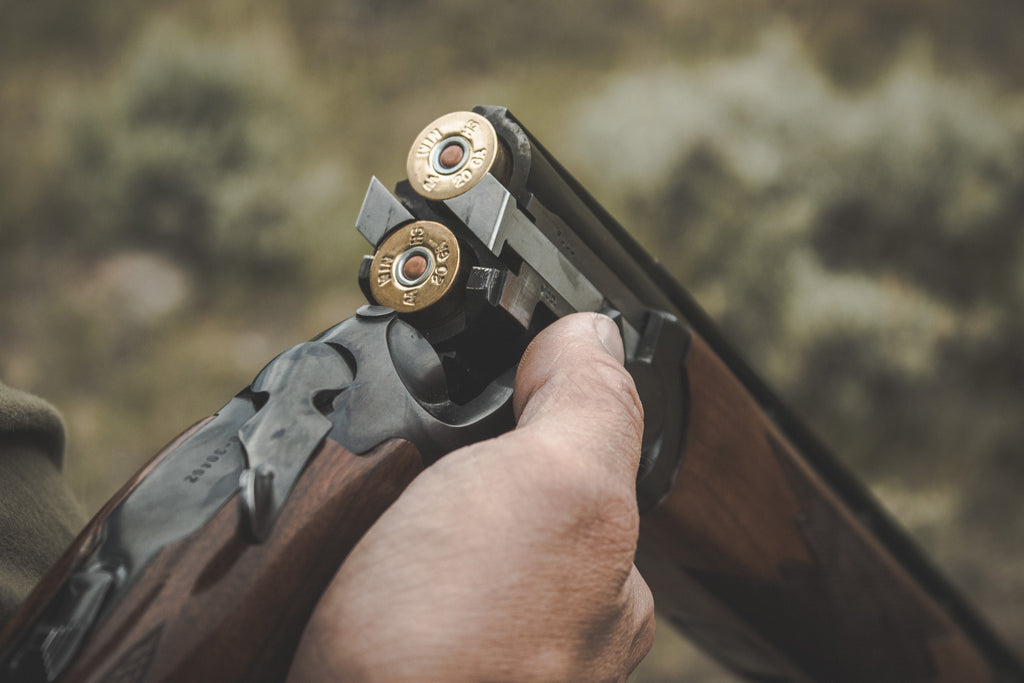The Iconic Ruger Red Label

I hate over/unders. Or at least I did. I much preferred the classic side-by-side shotgun. However, that changed when a Red Label came across my bench to get some work done. I immediately noticed how clean it looked, the receiver had no exposed screws or pins, and it was attractively sculpted and blued. It looked like a working man’s shotgun.
That wasn’t what sold me on it. I picked a spot on the shop wall and mounted the robust 20 gauge as if a pheasant flushed in front of me. It felt right and pointed. I lowered the gun and told myself I would have to pick it up.
My first experience with the Ruger Red Label isn’t uncommon. The Ruger Red Label is a classic, plain and simple. Both loved and hated, it's hard to argue with its clean lines and bulletproof reputation.

Bill Ruger set the shotgun market on fire when he announced the audacious goal of providing Americans with an affordable Over/Under (O/U) shotgun made by Americans. This would also be the first shotgun model that Ruger produced. In addition, he decided to do what he did best, focus on streamlining the manufacturing process. Historically, O/U shotguns required a lot of handwork to get a finished product. He changed that by employing revolutionary manufacturing techniques.
The Ruger Red Label was hugely successful when it hit the market in 1978. First offered in 20 gauge, the 12 gauge followed the next year. By 1994, there was enough interest in a 28 gauge that Ruger scaled the receiver down to fit the popular little sub-gauge. All Red Label production ceased in 2011 for a short time. It was re-engineered for ease of manufacturing and rereleased in 2013. Ruger discontinued the Red Label a year and a half later.
The Ruger Red Label’s Features
As previously mentioned, the Red Label was built to be a working man’s over/under. But that didn’t mean it couldn’t be full of many features previously reserved for higher-end guns.
First and foremost, it is strong! It has the reputation of being the strongest locking system ever built on an Over/Under Shotgun. This is because of the way the receiver is manufactured. Unlike most break-open shotguns, there isn’t a pin that the barrels rotate on. Instead, this surface is machined into the receiver making it one piece. As a result, many users have put tens of thousands of shotgun shells through them without the slightest amount of play in the barrels.

The Red Label assisted opening feature made it easy to open the gun to load. When rotating the top lever, you’ll notice that at the last fraction of an inch, the barrels will move slightly forward before opening. This allows them to clear the receiver's face and reduces wear. You will have difficulty finding an O/U shotgun that is easier to open. Purdey made a similar type of easy-opening system famous back in 1880!
The hammers cock on opening, typically making a gun stiff to open after firing. However, the Red Label employed rebounding hammers. After firing, the hammers “rebound” back to a spot where they are not touching the firing pins. This is also a safety feature, as the hammers must be fully cocked before they can reach the primer.

The Red Label has a mechanical single trigger made of stainless steel. It is especially noted for its safety features. While the single trigger is mechanical, it uses an inertia block to prevent a double fire. The safety also serves as the barrel selector and is automatically put on “safe” when the gun is opened, a feature hated by some and loved by others.

The barrels were ahead of their time and were rated for steel shot from the factory. Initially, they were made with fixed chokes. In 1988, screw-in chokes were introduced and became standard in 1991. The fixed chokes can easily be identified by reading the stamping on the side of the barrels that is visible when the gun is opened up. The old model had removable barrel side panels if you wanted to slightly reduce the weight or preferred the look and feel of seeing the space between the barrels.
The barrels are made of Chrome-Moly steel and silver soldered to the monobloc. It sports a ventilated rib dovetailed onto the barrel, making it nearly impossible for it to separate from the barrels. The rib is matted to provide an excellent anti-glare finish and sports a single brass bead at the end of the barrel. In addition, the 30” barrel model includes a second gold bead halfway down the barrel.

The Red Label is fitted with some of the most robust extractor/ejectors, rarely causing issues for shooters. Like your standard ejectors, empty shotgun shells are thrown clear of the gun when fired. When not fired, they work as extractors, raising the shells high enough to grab with your hands. This mechanism works with each individual barrel; if you only shoot the top barrel, the top shell ejects while the bottom extracts.
Extractors & Ejectors: What You Need To Know
With a 14” length of pull(LOP), the stock is dimensioned to fit the average American shooter. The drop at comb is 1 ½”, the drop at heel is 2 ½”, and it sports a very comfortable pistol grip. The wood-to-metal fit could be better and tends to be one of the biggest complaints about the Red Label. The Forearm has a Deeley and Edge style forearm takedown, making it very easy to take down for cleaning. The Red Label was stocked with American Walnut, some fancier than others. I was lucky enough to get one with excellent figure and color.
Lastly, I challenge you to find a better looking over/under. As mentioned previously, the receiver is very clean, meaning no screws or pins are protruding. It is sculpted with beautiful lines that only complement the clean look. The stock is a traditional American design, without the extreme drop. The checkering is a pointed pattern checkered at 20 lines per inch, giving you the perfect balance of grip and aesthetics.
The Beloved Red Label
Finding a Red Label at your local used gun store is unlikely. Most people who have them hold onto them for the reasons listed above. Gunbroker is the best place to find them, but you lose the ability to pick it up and visually inspect it. There are some very interesting variations found out there, including an “All-Weather” one that was made out of stainless steel and sported a synthetic stock! Also, they had a unique “woodside” model that had extra metal removed from the receiver and wood that replaced it, shaped like lockplates.

While this gun may not be perfect for everyone, it has become the go-to for those that own them. They have become legendary pheasant guns in the midwest and probably account for thousands of birds each year. I encourage you to pick one up if you see it on the rack of your local gun shop and experience what a true American-made over/under feels like.
Written by Kurt Martonik
